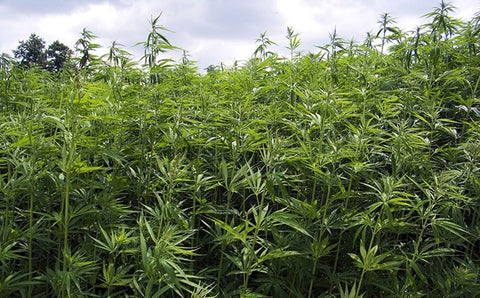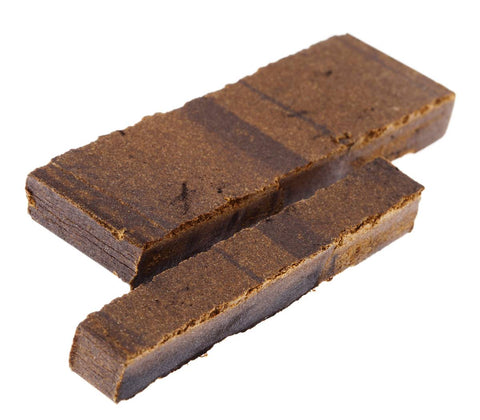Hemp is a versatile and sustainable crop with a wide range of applications; from creating CBD hashish and edibles to building materials and biofuel, hemp can be used in a variety of industries as well as by individual growers.
There are many different species of the cannabis plant. Still, hemp — the only variety of cannabis you can legally apply for a license to grow from the Home Office for — comes exclusively from the cannabis sativa family. For this reason, it's crucial that before hemp plants are used, they must first be correctly identified.
Whatever you’d like to use hemp for, our HempHash identification guide can help you to differentiate between the anatomies of hemp and marijuana. We’ll also cover how to recognise hemp plant components from those of other cannabis plants.
The Anatomy of a Hemp Plant
The key difference between marijuana and hemp isn't just their chemical composition (i.e. THC and CBD content).
Contrary to popular misconception, several physical differences between the two are readily apparent to the naked eye, and you don't need a magnifying glass to discern them!
Let's look at some examples of these below.
Hemp Seeds
Hemp seeds measure two to three millimetres across. They are typically a light shade of green, encased in thin, black hulls, unlike marijuana's smaller, dark brown seeds with hard outer shells.
Not to be overshadowed by their more mature iterations, hemp seeds have plenty of utility in their own right. They're often used in beauty products and health supplements because of their high levels of essential fatty acids – necessary for maintaining healthy skin and hair. Additionally, they're a good source of protein, which is vital for cell growth and regeneration.
If you aren't impressed yet, hemp seed also contains vitamins and minerals that can benefit skin health, such as vitamin E, potassium, and magnesium. This makes them a great organically-derived option for people seeking beauty products that naturally nourish the skin.

Hemp Stalk
The stalks of hemp and marijuana plants have some notable differences. For one, hemp plants have long stalks that can grow up to three metres, with branches extending from distinct joints. These branches stay much closer to the actual hemp plant than marijuana, with a tendency to grow upwards rather than spreading horizontally.
Hemp stalks have significantly more nodes and contain tough hemp fibres that can be processed into anything from environmentally friendly paper to sturdy ropes.
The woody core of hemp stalks can even be utilised in the production of Hempcrete, which is a highly practical and well-researched alternative to concrete with arguably superior insulation and moisture resistance.
Hemp Leaves
Leaf anatomy is arguably the most distinguishable aspect between hemp plants and marijuana. Most notably, hemp has slender, skinnier leaves with serrated leaflets. The number of leaflets (sometimes called "fingers") on each leaf can vary significantly between lower and higher growers, but the number of leaflets is consistently odd in hemp plants.
As with other cannabis sativa plants, hemp leaflets are thinner and grow further apart compared to indicas. They typically grow in opposing pairs and range between green and purple hues.
Manufacturers use hemp leaves for various purposes, including as source material for making paper, textiles and even bioplastics. They can also be used as a food source or, as in traditional medicine, for their high content of minerals and vitamins.
Hemp Flower (or Buds)
Much like any plant in the same species, the highest concentration of beneficial hemp compounds — including cannabinoids, terpenes and flavonoids — can be found in their flowers.
Hemp flowers, also commonly known as "CBD flowers", are easily recognisable by their unique aroma and appearance. They're typically noticeably smaller and thinner than marijuana flowers with more muted colours, ranging from pale green to brown.
More recently, however, cultivation techniques for CBD flower have improved and some strains are comparable in quality to THC flower. Many indoor cultivars are now producing light to mid-green, beautiful, large and dense trichome-covered flowers. These flowers can contain a multitude of colours, such as orange and purple hues and intricate details.
On the other hand, marijuana flowers are usually larger with brighter colours, including pink, purple, or even blue.
Another way you can quickly identify hemp flowers is by their THC content. Hemp flowers contain very little to negligible levels of THC, while marijuana buds and flowers (except for a few specific strains) can contain up to 30% THC. This isn't to say that hemp flowers aren't without their uses; they're a natural choice in the brewing of CBD tea, as well as the formulation of homemade balms or use in dry herb vaporisers.
CBD flower is particularly popular for its impressive indoor cultivated selection, including standout varieties like Limoncello, Pineapple Tonic, Harlequin and V1.

How to Tell the Difference Between Male & Female Hemp Plants
A brief analysis of a hemp plant's nodes (where leaves separate from its stalk) is the surest method of determining a hemp plant's gender. As early as five weeks into their growth cycle, distinguishable development shows in these nodes. Males will manifest sacs containing pollen for fertilisation, while females will have slender growths similar to strands of hair.
The distinctions between male and female hemp plants are critical for anyone involved in the cannabis industry. Understanding these differences is key to grasping their respective advantages and disadvantages and determining which gender is more suited for specific use cases.
Let's examine more differences between gendered hemp plants below:
Male Plants
- Tend to be taller and thinner than female plants
- Best able to resist pests and disease; often more so than female and hermaphroditic plants
- Typically have fewer leaves than female plants
- Fastest growth rate; can be harvested significantly earlier than female plants
- Produce cannabis flowers with the most pollen when compared to female and hermaphroditic plants
- Ideal cannabis plant for industrial hemp farming and production of hemp-derived industrial materials
Female Plants
-
Produces more CBD than male plants
-
Tend to produce more terpenes than male plants
-
Tend to produce less THC than male plants
-
Tends to be more robust than male plants
-
Produces more flowers and seeds than male plants
-
Ideal cannabis plant for the production of hemp seed oil and CBD products
Hermaphroditic Plants
- Extremely hardy and resilient; often more so than female hemp plants
- Can develop both female and male flowers
- Can both self-pollinate and fertilise female hemp plants
- Because of the ability to self-pollination, much less at risk of cross-pollination with other nearby plants
- Significantly less risk of so-called "seedcakes" because of protection from cross-pollination
- Has the potential to produce female hemp flowers with higher cannabinoid content than those of female plants
Chemical Composition of the Hemp Plant
The hemp plant is composed of many different chemicals, most prominently cannabinoids, which are concentrated in hemp buds and flowers.
In most cases, hemp produces THC at trace levels. However, hemp’s production of non-psychoactive cannabinoids like CBD, CBG (cannabigerol) and CBN (cannabinol) is on par with others in the cannabis sativa species. This makes hemp plants viable for the formulation of isolates, and broad- and full-spectrum products.
Hemp doesn't produce terpenes in large quantities, but there may be some in trace amounts. Some terpenes commonly detected in hemp include myrcene, limonene, alpha-pinene, and beta-caryophyllene. These may interact with cannabinoids like CBD to produce various synergistic "entourage effects," which are actively being studied by medical researchers.
On the other hand, hemp does produce appreciable amounts of flavonoids, a category of phytonutrients or plant-based chemicals that offer health benefits. Some of the most well-known flavonoids include antioxidants, which help protect the body against damage from free radicals. Like terpenes, flavonoids lend to the therapeutic potential of the hemp plant by playing into the potential entourage effects associated with everything from full-spectrum CBD to hemp-derived skincare options.
Flowers aside, hemp hurds (i.e. shives) contain a high concentration of alpha-cellulose (about 45%), hemicellulose, lignin and pectin, all of which contribute to the rigidity and robustness of products sourced from the inner core of the stalks of hemp plants.
How HempHash Sources the Best Hemp Buds & Flowers for our Products
Our hemp flowers contain less than 0.2% THC, staying well under the legal limits specified in existing laws and industry regulations within the United Kingdom.
We work exclusively with natural, unadulterated crops cultivated using organic methods. Our buds and flowers are hand-selected with care to ensure our source materials (as well as our final products) are of the highest standard — free from mould, spores, pesticides or other environmental contaminants.
HempHash does not use terpenes or other aroma compounds to enhance our products' flavour or aroma profile, nor do we add isolates to our products to boost their cannabinoid content.
Throughout the cultivation, extraction, processing and packing procedures, HempHash holds itself above industry best practices, producing a sustainably-sourced, cruelty-free and almost entirely vegan-friendly selection of products.
Best of all, our items are certified by third-party testing laboratories as containing no less than the concentrations of cannabinoids printed on our labels so that you can purchase from HempHash confidently.



